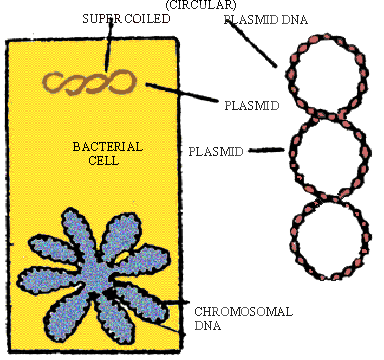|
PinkMonkey Online Study Guide-Biology
8.5 Plasmids
In addition to the normal DNA chromosome, extrachromosomal
genetic elements are often found in the cytoplasm of most bacterial species
and in some species of eukaryotes. These elements are called plasmids.
Plasmids are extrachromosomal circular DNA molecules (except
the plasmid called Killer-Plasmid present in yeast cells, which is a double
stranded RNA molecule). The DNA of all plasmids is double stranded supercoiled
circular DNA molecule (Figure 8.8). These are capable of autonomous replication
in the cytoplasm of the bacterial cell. Therefore, plasmids are also described
as autonomously replicating íminichromosomesí. A bacterial cell can have
one to many copies of a plasmid. Plasmids represent extra genes.
Some plasmids are called episomes. An episome is a plasmid
with a dual ability to replicate, i.e. it can replicate autonomously
in the cytoplasm like other plasmids or it can also integrate itself
into the DNA of the bacterial chromosome and behave as part of the
chromosome.
Role of plasmids
Many plasmids contain important and essential plasmid genes which are helpful under certain conditions. For example, a bacterial cell possessing R Plasmid develops resistance to certain antibiotics. Similarly, presence of some plasmids gives the bacterial cell the ability to produce toxins (toxigenicity), or the ability to use unusual chemical compounds as nutrients. Moreover, plasmids and episomes prove to be good vehicles for gene manipulations (genetic engineering).
 Figure 8.8 Bacterial cell showing a plasmid
Figure 8.8 Bacterial cell showing a plasmid
|